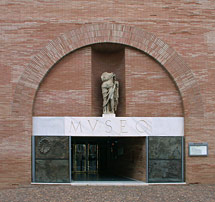 |
Mérida was the most important city in Spain at the end of the Roman Empire. The presence of the Theater and the Arena stand out among the ruins of its past. Not far from these monumental relics is the site for the museum. The first intention of the project was to build a museum which would offer to the people of Mérida an opportunity to recover the lost presence of the Roman town over which the new city had been built. Moreover, a certain will to recall and evoke the Roman past can be felt in the project: the museum, without falling into a strict imitation of Roman architecture, tries to suggest to the visitor how the Roman Mérida was in its time. The desire to approach the Roman world that is the basis of the project is satisfied by literally adopting Roman construction systems and not by merely applying moldings and orders. For that reason, the Roman construction system—massive masonry-bearing walls filled with concrete—has given rise to a building in which the structure of the walls gives formal support to the architecture, an architecture of walls, in which the problem of intervals, proportions, and openings are the key elements. A system of parallel walls is hollowed out by means of a large arch, forming a virtual perspective, a nave that is the main space for some of the museum's the most valuable pieces. The translucent white marble of the relics may be seen in dialectical interplay with the material presence of the brick wall in so far as the natural illumination entering through skylights in most cases stimulates the dialogue between the works of art and the walls. The crypt clearly shows the museum's proposal to uncover the presence of the old Roman city.




